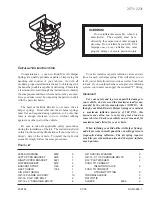
G
WARNING
Seat belts cannot protect as intended, if:
R
they are damaged, extremely dirty,
bleached or dyed
R
the seat belt buckle is damaged or
extremely dirty
R
the Emergency Tensioning Devices or the
belt anchorage has been modified.
Damage caused to seat belts in an accident
may not be visible, e.g. by splinters of glass.
Modified or damaged seat belts can tear or
fail, for example in the event of an accident.
Modified Emergency Tensioning Devices may
be deployed unintentionally or fail to be
deployed when required. There is an
increased risk of injury, possibly even fatal.
Never modify seat belts, Emergency
Tensioning Devices, seat belt anchorages and
inertia reels. Ensure that seat belts are not
damaged or worn and are clean.
Only use seat belts that have been approved
for your vehicle by Mercedes-Benz.
The use of seat belts and infant and child
restraint systems is required by law in:
R
all 50 states
R
the U.S. territories
R
the District of Columbia
R
all Canadian provinces
Even where this is not required by law, all
vehicle occupants should correctly fasten
their seat belts before starting the journey.
i
See "Children in the vehicle"
(
Y
page 55) for further information on
infants and children traveling in the vehicle
as well as on child restraint systems.
Proper use of the seat belts
G
WARNING
USE SEAT BELTS PROPERLY
R
Seat belts can only work when used
properly. Never wear seat belts in any other
way than as described in this section, as
that could result in serious injuries in the
event of an accident.
R
Each occupant should wear their seat belt
at all times, because seat belts help reduce
the likelihood of and potential severity of
injuries in accidents, including rollovers.
The integrated restraint system includes
SRS (driver front air bag, knee bags, front-
passenger front air bag, side impact air
bags, head air bags), Emergency
Tensioning Devices (ETDs) and seat belt
force limiters. The system is designed to
enhance the protection offered to properly
belted occupants in certain frontal (front air
bags, knee bags and ETDs) and side (side
impact air bags, head air bags and ETDs)
impacts which exceed preset deployment
thresholds.
R
Never wear the shoulder belt under your
arm, across your neck or off your shoulder.
In a frontal crash, your body would move
too far forward. That would increase the
chance of head and neck injuries. The seat
belt would also apply too much force to the
ribs or abdomen, which could severely
injure internal organs such as your liver or
spleen.
Adjust the seat belt so that the shoulder
section is located as close as possible to
the middle of the shoulder (it should not
touch the neck).
R
Position the lap belt as low as possible on
your hips and not across the abdomen. If
the lap belt is positioned across your
abdomen, it could cause serious injuries in
a crash.
R
Never wear seat belts over rigid or
breakable objects in or on your clothing,
such as eyeglasses, pens, keys etc., as
these might cause injuries.
R
Make sure the seat belt is always fitted
snugly. Take special care of this when
wearing loose clothing.
R
Never use a seat belt for more than one
person at a time. Do not fasten a seat belt
52
Occupant safety
Safety
Содержание SLK
Страница 4: ...I n f o r m a t i o nP r o v i d e db y...
Страница 38: ...36 I n f o r m a t i o nP r o v i d e db y...
Страница 96: ...94 I n f o r m a t i o nP r o v i d e db y...
Страница 138: ...136 I n f o r m a t i o nP r o v i d e db y...
Страница 254: ...252 I n f o r m a t i o nP r o v i d e db y...
Страница 255: ...Useful information 254 Stowage areas 254 Features 256 253 Stowage and features I n f o r m a t i o nP r o v i d e db y...
Страница 288: ...286 I n f o r m a t i o nP r o v i d e db y...
Страница 353: ...351 I n f o r m a t i o nP r o v i d e db y...
Страница 354: ...352 I n f o r m a t i o nP r o v i d e db y...
















































